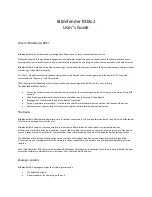
Understanding Static NAT
Static NAT refers to persistent one-to-one address mapping translation. In contrast to dynamic NAT, the static
address translation does not vary over time. For inbound access to the internal local hosts, you should use static
NAT rules. A static NAT rule maps an external IP address to a specific internal host's internal IP address. An
internal IP address may be assigned to different external addresses on different interfaces.
Warning: If you expose your internal DNS servers using a static NAT rule, you do not benefit from the address
hiding feature provided by translation rules. External users can simply request information about your trusted
networks from the DNS servers that you expose.
Example Use Scenario
Scenario: We can define a static NAT rule that maps from the external IP address 192.168.7.130 (translated
address) to the internal file server 192.168.1.3 (real address).
For this scenario, PIX Device Manager generates a rule similar to the following:
static (inside, outside) 192.168.7.130 192.168.1.3 netmask 255.255.255.255 0 0
Description: When the PIX Firewall unit receives a session request where the source address matches the IP
address of the internal file server, it changes the source address to the external IP address before placing the
packet onto the network of which the external address is a member. Likewise, when the PIX Firewall unit
receives a network packet destined for the translated address, it changes the destination address to the address of
the internal file server and places the new packet onto the network to which the internal file server belongs. Thus,
the internal file server processes the packet as though it were originally destined for the file server. In both cases,
all packets that are part of a valid session are remapped according to the translation rule (assuming that the active
security policy permits the communication). If the active security policy does not permit a specific
communication, the session request is rejected and the translation never occurs.
Copyright © 2001
Cisco Systems, Inc.
Summary of Contents for PIX 520 - PIX Firewall 520
Page 45: ...Copyright 2001 Cisco Systems Inc ...
Page 68: ...Copyright 2001 Cisco Systems Inc ...
Page 74: ...Copyright 2001 Cisco Systems Inc ...
Page 87: ...Copyright 2001 Cisco Systems Inc ...
Page 92: ...Copyright 2001 Cisco Systems Inc ...
Page 108: ......
Page 184: ......
Page 197: ...Copyright 2001 Cisco Systems Inc ...
Page 200: ......
Page 232: ...Copyright 2001 Cisco Systems Inc ...
Page 246: ...Copyright 2001 Cisco Systems Inc ...






































